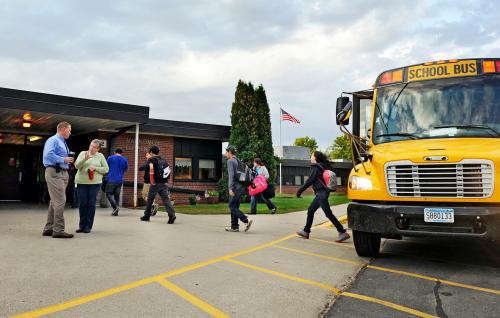Much has recently been written about the growing problem of teacher shortages. While such shortages may sometimes result from, or lead to, high rates of teacher turnover at the school level, turnover—defined as the yearly rate of departure of teachers from a school—is of policy interest in its own right. It imposes financial costs on schools and districts because of the need to find replacement teachers, and it has been shown to reduce student achievement.
Here we highlight a concern related to the within-school turnover of middle school teachers, namely the disruption of teacher staffing in core subjects. We draw on a recent paper in which we examined how middle schools in North Carolina responded to changes in the rates of turnover of their math and English language arts (ELA) teachers in grades six, seven, and eight from 1998 to 2016.
Turnover is inherently disruptive
Within a middle school, the teachers of a single subject area are likely to teach similar types of material, may work together to offer a coherent curriculum, and, to some extent, may be interchangeable. Regardless of whether a teacher leaves one school to move to another school or quits the profession, the departure of one is likely to affect the others. We focus on middle school teachers because comparable groups of teachers would be difficult to identify at the elementary school where self-contained and multi-subject classrooms are more common, or at the high school level where subjects often become highly specialized. The middle school subjects of math and ELA are also student tested subjects, and therefore directly affect a school’s accountability rating.
When teachers leave a school, one option for the school is not to replace them and to opt instead to raise class sizes. Alternatively, the school may replace departing teachers with other teachers who have either weaker or stronger qualifications, or it might switch teachers across subjects. In contrast to much of the earlier research on teacher mobility, our approach allows us to examine the net effects of teacher turnover on the mix of teachers in a school, where net effects take into account both the qualifications of the teachers who leave and the qualifications of those who replace them.
Turnover rates and pattern over time
We are interested in responses to teacher turnover by school, subject, and year. The figure shows that turnover rates (as measured by three-year averages of math and ELA teachers in middle schools) exhibited substantial variation in North Carolina over our 18-year time period and are currently high.
Starting at about 23% in 1998, the rate rose reasonably steady to nearly 28% in 2008, before dropping precipitously during the recession. The recession-induced drop is not surprising given that teaching jobs may be preferable to outside options during a period of rising unemployment. But the turnover rate then increased from its nadir in 2012 to 29% in 2016, the final year of our sample.
Our empirical strategy was straightforward: Our goal was to estimate how changes in a school’s turnover rate affect the mix of teachers or class sizes in the following year, controlling statistically for other factors that might affect the outcomes (including school or school-by-year fixed effects). Our outcome variables are the percentages of teachers with three or fewer years of experience, with lateral or provisional licenses, or who are teaching out of subject; average teacher licensing exam scores; and average class sizes. We chose the four teacher characteristics because studies show they are predictive of student achievement. The class size measure allowed us to determine if schools responded to teacher turnover by raising class sizes, a change that could also be detrimental to student outcomes.
The evidence is clear that higher teacher turnover leads to higher proportions of teachers with limited experience, lateral entry teachers, or those with provisional licenses. The increased reliance on lateral entry teachers or those with provisional licenses was particularly evident among schools with large concentrations of low-performing students or high rates of poverty. We found no differential responses across urban and rural schools, or schools categorized by their geographic distances to the nearest teacher education program.
Somewhat less consistent evidence suggests that schools also respond by hiring teachers with lower licensure scores or by increasing the proportions of teachers teaching out of subject. We find essentially no evidence that middle school administrators in North Carolina respond to teacher turnover in their schools by increasing class sizes. That is not surprising given that math and ELA are core subjects with state end-of-grade tests and that the state has maximum course size regulations.
Importance and policy implications
Our empirical findings highlight three potential mechanisms through which high rates of teacher turnover may adversely affect the joint capacity of teachers within a middle school. First, the resulting higher proportions of teachers with weak qualifications are likely to reduce the quality of teaching, and, as shown in prior studies, to reduce student achievement. Second, the influx of new and inexperienced teachers is likely to be disruptive and could interfere with the development of a coherent curriculum. Lastly, the compositional change is likely to increase turnover in subsequent years because of the greater proclivity of novice teachers and alternatively certified teachers to leave schools.
The potential for higher subsequent turnover strengthens the case for policymakers to address directly the challenges posed by high teacher turnover rather than focusing only on longer-term strategies designed to improve the quality of the overall teacher labor force. One strategy for reducing the probability of high rates of teacher turnover is to improve school working conditions by raising the quality of a school’s leadership or providing differential pay for teachers to remain in hard-to-staff schools or subjects. A complementary strategy would be to adopt policies designed to make schools more resilient to the loss of teachers, like enhancing the teacher pipeline for such schools and providing strong mentorship programs for early career teachers. While those policies might also help reduce overall teacher shortages, their main goal would be to reduce high rates of teacher turnover within individual schools and thereby to enhance the quality of those schools.
The Brookings Institution is committed to quality, independence, and impact.
We are supported by a diverse array of funders. In line with our values and policies, each Brookings publication represents the sole views of its author(s).








